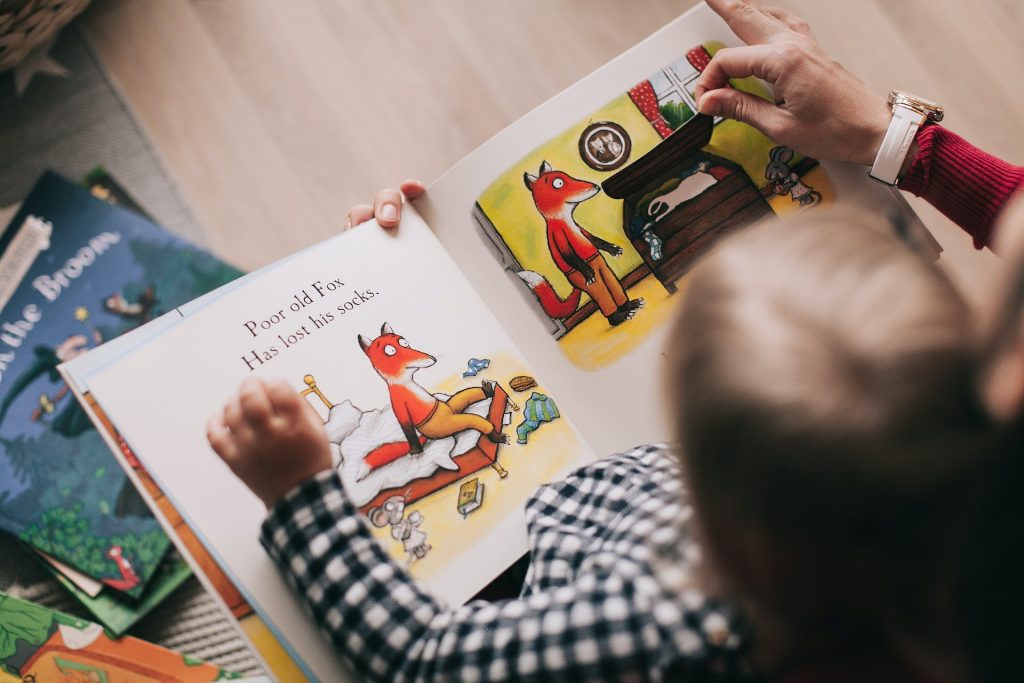Discover effective strategies and tips for teaching reading to 3-4 year old children.
How to Teach Reading to a 3-4 Year Old Child
Teaching reading to a 3-4 year old child can be an exciting and rewarding experience. As children at this age are constantly absorbing information and developing their cognitive skills, it is the perfect time to introduce them to the world of reading. By understanding their learning capacity, creating a literacy-rich environment, choosing the right books, and utilizing engaging techniques, you can make reading a fun and enjoyable activity for your little one. Let’s dive into each of these aspects and explore how you can help your child become a confident reader!
Understanding the Learning Capacity of a 3-4 Year Old

Before embarking on this reading journey, it’s important to understand the learning capacity of a 3-4 year old. At this age, children are experiencing rapid cognitive development. Their brains are like sponges, absorbing everything they come across. Additionally, language acquisition is at its peak during this time, making it easier for them to soak up new words and sounds. By taking advantage of these developmental milestones, you can make the reading experience more enjoyable and effective for your child.
During early childhood, children develop various cognitive skills that are crucial for reading. Their memory capacity expands, enabling them to remember and recognize letters, words, and patterns. They also start to develop problem-solving abilities and critical thinking skills. By incorporating activities that stimulate these cognitive functions, such as puzzles, memory games, or simple word games, you can enhance your child’s overall reading readiness.
Language acquisition plays a fundamental role in learning to read. Children at the age of 3-4 have a growing vocabulary and can understand basic sentence structures. They are also able to express themselves using simple sentences. By exposing your child to a rich language environment, through conversations, storytelling, and reading aloud, you provide them with the necessary foundation for reading. Make conversations a part of your daily routine and encourage your child to communicate their thoughts and ideas.
Expanding Cognitive Development in Early Childhood
In addition to memory capacity, there are other cognitive skills that develop during early childhood and contribute to reading readiness. One of these skills is attention span. At the age of 3-4, children are able to focus on an activity for a longer period of time, which is essential for sustained reading. You can help your child improve their attention span by engaging them in activities that require concentration, such as completing puzzles or playing board games.
Another important cognitive skill is spatial awareness. Children at this age are becoming more aware of their surroundings and can understand spatial relationships. This skill is crucial for understanding the layout of a book and following the flow of text from left to right. You can enhance your child’s spatial awareness by providing them with opportunities to explore their environment, such as playing with building blocks or engaging in imaginative play.
Expanding Language Acquisition at this Age
In addition to conversations, storytelling, and reading aloud, there are other ways to expand your child’s language acquisition at the age of 3-4. One effective method is through singing. Music has a powerful impact on language development, as it exposes children to different rhythms, melodies, and lyrics. Singing nursery rhymes or children’s songs together can not only be fun but also help your child develop phonological awareness, which is an essential skill for reading.
Another way to expand language acquisition is through exposure to different languages. Research has shown that children who are exposed to multiple languages at an early age have a greater capacity for language learning later in life. You can introduce your child to different languages through books, songs, or even by enrolling them in language classes or playgroups.
Furthermore, incorporating sensory experiences into your child’s language learning can be highly beneficial. Engaging their senses, such as touch, smell, and taste, while exploring different objects or materials can help them make connections between words and their real-world experiences. For example, you can create sensory bins filled with various textures and objects related to a specific theme, and encourage your child to describe what they see, feel, and smell.
Preparing Your Child for Reading
Creating a literacy-rich environment is key to preparing your child for reading success. Surrounding them with books, letters, and words sparks their curiosity and motivates them to explore the world of reading further.
When it comes to preparing your child for reading, it’s important to go beyond just providing books. Creating a literacy-rich environment involves thoughtful planning and attention to detail. One way to do this is by designating a cozy reading corner in your home. This special space should be filled with colorful and age-appropriate books that cater to your child’s interests. By having a variety of books readily available, you are giving your child the opportunity to choose what they want to read, fostering a sense of independence and ownership in their reading journey.
But it’s not just about having books on display. How you present them also matters. Display the books at your child’s eye level, making them easily accessible and visually appealing. Consider creating a small bookshelf or stacking the books in an inviting manner. This not only adds an element of organization but also makes the books more enticing to explore. Additionally, you can enhance the literacy-rich environment by having alphabet posters or letter magnets on display. These visual aids serve as constant reminders of the building blocks of reading and can spark your child’s curiosity about letters and words.
Creating a Literacy-Rich Environment
Designate a cozy reading corner in your home, filled with colorful and age-appropriate books. Display these books at your child’s eye level, making them easily accessible and visually appealing. Create a small bookshelf or stack books in an inviting manner. In addition to books, have alphabet posters or letter magnets on display. This visually stimulating environment will engage your child and make reading a natural part of their daily routine.
Furthermore, a literacy-rich environment goes beyond the physical space. It also involves incorporating reading into your daily activities. For example, you can create a print-rich kitchen by labeling different items with words or using magnetic letters to spell out words on the refrigerator. This not only exposes your child to words in different contexts but also makes reading a seamless part of their everyday life.
Another aspect of creating a literacy-rich environment is modeling reading behavior. Let your child see you reading books, newspapers, or magazines. When they observe you engaging with reading materials, they are more likely to develop a positive attitude towards reading themselves. You can also read aloud to your child, exposing them to different genres, vocabulary, and storytelling techniques. This shared reading experience not only strengthens your bond but also helps them develop listening skills and a love for stories.
Importance of Regular Reading Sessions
Consistency is key when it comes to teaching reading. Set aside regular reading sessions with your child, ensuring that you have a quiet and distraction-free environment. Keep these sessions short and sweet to match their attention span. Aim for a few minutes multiple times a day rather than one long session. This not only helps maintain their interest but also enhances their concentration and reading abilities.
During these reading sessions, make sure to engage your child by asking questions, discussing the story, and encouraging them to make predictions. This interactive approach not only deepens their understanding of the text but also fosters critical thinking skills. As your child progresses in their reading journey, gradually increase the complexity of the books you read together. This allows them to expand their vocabulary, comprehension skills, and overall reading proficiency.
Remember, preparing your child for reading is an ongoing process. By creating a literacy-rich environment and incorporating regular reading sessions into their routine, you are setting them up for reading success. So, start building that cozy reading corner, surround them with books, and watch as their love for reading blossoms.
Choosing the Right Books for Your Child
Choosing the right books for your child is vital in capturing their interest and fostering a love for reading. Age-appropriate reading materials that align with your child’s interests and developmental stage are the way to go.

Age-Appropriate Reading Materials
Look for books with simple and repetitive language, vibrant illustrations, and a relatable storyline. Board books or books with touch-and-feel elements are great options for younger children. As they progress, opt for picture books with more detailed illustrations and a slightly longer narrative. Keep in mind that at this age, children enjoy stories that reflect their own experiences or explore familiar themes such as animals, family, friendship, and adventure.
Interactive Books for Engaging Reading
Interactive books, such as lift-the-flap, pop-up books, or books incorporating textures, sounds, or scents, can make reading more engaging and interactive for your child. These books provide a multisensory experience, capturing your child’s attention and making the reading process enjoyable. Encourage your child to explore and interact with the book elements while you read aloud.
Techniques to Teach Reading
When it comes to teaching reading, there are various approaches you can take. Phonics-based and whole language approaches are two popular methods that can be used in combination, depending on your child’s learning style and preferences.
Phonics-Based Approach
Phonics involves teaching children the relationship between letters and sounds. Start by introducing letter recognition and their corresponding sounds. Use flashcards, alphabet puzzles, or interactive apps to reinforce these concepts. As your child becomes familiar with basic letter sounds, gradually introduce blending sounds to form simple words. Practice word families (e.g., cat, mat, sat) to enhance their phonemic awareness. Engage in rhyming games to develop their sound discrimination abilities.
Whole Language Approach
The whole language approach focuses on the meaning and context of the text. Read aloud to your child using expressive voices and gestures. Encourage them to retell the story in their own words. Ask open-ended questions that promote critical thinking and comprehension skills. Point out sight words that appear frequently in the text. By immersing your child in meaningful and enjoyable reading experiences, you foster their love for stories and strengthen their overall reading comprehension.
Making Reading Fun and Engaging
Learning to read should be a fun and exciting adventure for your child. To keep them motivated and engaged, infuse creativity and playfulness into your reading sessions.
Incorporating Games into Reading
Transform learning into a playful experience by incorporating games into your reading routine. Create word scavenger hunts, where your child searches for specific sight words or letter sounds hidden around the house. Use flashcards or magnetic letters to build words together. Play “I Spy” while reading books, asking your child to find particular letters or words on the pages. These games make learning enjoyable, improve attention span, and reinforce reading skills.
Using Technology to Aid Reading
Harness the power of technology to strengthen your child’s reading skills. There are numerous educational apps and websites that offer interactive stories, phonics games, and reading comprehension exercises. Explore these resources together, ensuring that screen time is balanced and monitored. Consider audiobooks or e-books, which provide a multisensory experience and can spark your child’s interest in reading independently.
By diving into the world of reading with your 3-4 year old child and utilizing these tips, you can set them on a path of literacy success. Remember, staying patient, enthusiastic, and fostering a love for reading are the keys to unlocking their full potential. Enjoy this wonderful journey of nurturing a lifelong reader!



